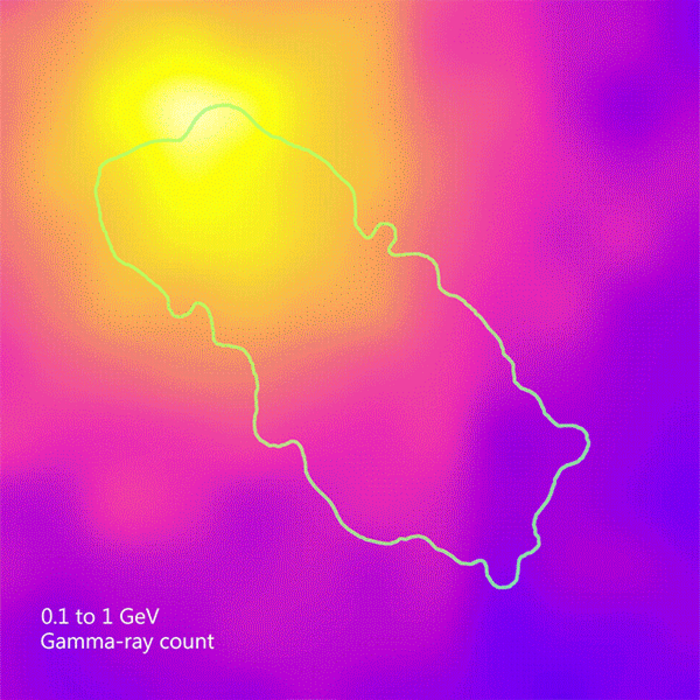Astronomers have long sought the launch sites for some of the highest-energy protons in our galaxy. Now a study using 12 years of data from NASA’s Fermi Gamma-ray Space Telescope confirms that one supernova remnant is just such a place.

Credit: NASA/Fermi/Fang et al. 2022
Astronomers have long sought the launch sites for some of the highest-energy protons in our galaxy. Now a study using 12 years of data from NASA’s Fermi Gamma-ray Space Telescope confirms that one supernova remnant is just such a place.
Fermi has shown that the shock waves of exploded stars boost particles to speeds comparable to that of light. Called cosmic rays, these particles mostly take the form of protons, but can include atomic nuclei and electrons. Because they all carry an electric charge, their paths become scrambled as they whisk through our galaxy’s magnetic field. Since we can no longer tell which direction they originated from, this masks their birthplace. But when these particles collide with interstellar gas near the supernova remnant, they produce a tell-tale glow in gamma rays – the highest-energy light there is.
“Theorists think the highest-energy cosmic ray protons in the Milky Way reach a million billion electron volts, or PeV energies,” said Ke Fang, an assistant professor of physics at the University of Wisconsin, Madison. “The precise nature of their sources, which we call PeVatrons, has been difficult to pin down.”
Trapped by chaotic magnetic fields, the particles repeatedly cross the supernova’s shock wave, gaining speed and energy with each passage. Eventually, the remnant can no longer hold them, and they zip off into interstellar space.
Boosted to some 10 times the energy mustered by the world’s most powerful particle accelerator, the Large Hadron Collider, PeV protons are on the cusp of escaping our galaxy altogether.
Astronomers have identified a few suspected PeVatrons, including one at the center of our galaxy. Naturally, supernova remnants top the list of candidates. Yet out of about 300 known remnants, only a few have been found to emit gamma rays with sufficiently high energies.
One particular star wreck has commanded a lot of attention from gamma-ray astronomers. Called G106.3+2.7, it’s a comet-shaped cloud located about 2,600 light-years away in the constellation Cepheus. A bright pulsar caps the northern end of the supernova remnant, and astronomers think both objects formed in the same explosion.
Fermi’s Large Area Telescope, its primary instrument, detected billion-electron-volt (GeV) gamma rays from within the remnant’s extended tail. (For comparison, visible light’s energy measures between about 2 and 3 electron volts.) The Very Energetic Radiation Imaging Telescope Array System (VERITAS) at the Fred Lawrence Whipple Observatory in southern Arizona recorded even higher-energy gamma rays from the same region. And both the High-Altitude Water Cherenkov Gamma-Ray Observatory in Mexico and the Tibet AS-Gamma Experiment in China have detected photons with energies of 100 trillion electron volts (TeV) from the area probed by Fermi and VERITAS.
“This object has been a source of considerable interest for a while now, but to crown it as a PeVatron, we have to prove it’s accelerating protons,” explained co-author Henrike Fleischhack at the Catholic University of America in Washington and NASA’s Goddard Space Flight Center in Greenbelt, Maryland. “The catch is that electrons accelerated to a few hundred TeV can produce the same emission. Now, with the help of 12 years of Fermi data, we think we’ve made the case that G106.3+2.7 is indeed a PeVatron.”
A paper detailing the findings, led by Fang, was published Aug. 10 in the journal Physical Review Letters.
The pulsar, J2229+6114, emits its own gamma rays in a lighthouse-like beacon as it spins, and this glow dominates the region to energies of a few GeV. Most of this emission occurs in the first half of the pulsar’s rotation. The team effectively turned off the pulsar by analyzing only gamma rays arriving from the latter part of the cycle. Below 10 GeV, there is no significant emission from the remnant’s tail.
Above this energy, the pulsar’s interference is negligible and the additional source becomes readily apparent. The team’s detailed analysis overwhelmingly favors PeV protons as the particles driving this gamma-ray emission.
“So far, G106.3+2.7 is unique, but it may turn out to be the brightest member of a new population of supernova remnants that emit gamma rays reaching TeV energies,” Fang notes. “More of them may be revealed through future observations by Fermi and very-high-energy gamma-ray observatories.”
NASA explores cosmic mysteries – and this particular puzzle took more than a decade of cutting-edge observations to solve.
The Fermi Gamma-ray Space Telescope is an astrophysics and particle physics partnership managed by Goddard. Fermi was developed in collaboration with the U.S. Department of Energy, with important contributions from academic institutions and partners in France, Germany, Italy, Japan, Sweden, and the United States.
Journal
Physical Review Letters
DOI
10.1103/PhysRevLett.129.071101
Article Title
Evidence for PeV Proton Acceleration from Fermi-LAT Observations of SNR G106.3 + 2.7
Article Publication Date
10-Aug-2022




